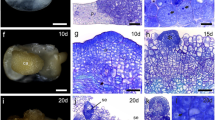Abstract
The tissue culture ofRubia cordifolia var.pratensis andR. akane were performed to enhance the biosynthesis of anthraquinone pigments under various conditions. The production of alizarin and purpurin in the callus was separately analysed and was quantitatively compared. The pigment biosynthesis was more active in the callus fromR. cordifolia var.pratensis than fromR. akane. The addition of α-ketoglutaric acid, a biosynthetic precursor of anthraquinones, enhanced the production of alizarin and purpurin remarkably.
Similar content being viewed by others
Literature Cited
Nielsen, H. and Hanke, V.: Heilpflanzen in Farbe, BLV, Muenchen, p.240 (1977).
Namba, T.: Coloured illustration of Wakan-Yaku, Hoikusha, Osaka, p.135 (1980).
Yook, C.S.: Medicinal plants of Korea, Jinmyeong, Seou, p.328 (1981).
Adwankar, M.K. and Chitnis, M.P.:In vivo anti-cancer activity of RC-18,Chemotherapy,28, 291 (1982).
Hsu, H.K., Chen, Y.P. and Hong, M.: The chemical constituents oriental herbs, Oriental Healing Arts Institute, Los Angeles, p.179 (1982).
Verma, N., Painuly, P., Sharma, S.C. and Tandon, J.C.: A new anthraquinone glycoside fromRubia cordifolia, IndianJ. Chem. 24, 791 (1985).
Itokawa, H., Mihara, K. and Takeya, K.: Studies on a novel anthraquinone and its glycosides isolated fromRubia cordifolia andR. akane, Chem. Pharm. Bull. 31, 2353 (1983).
Suzuki, H., Matsumoto, T. and Obi, Y.: Anthraquinones in cell suspension cultures ofRubia cordifolia var. Mungista Miq., Plant Tissue culture 1982, The Japanese association of plant tissue culture, Tokyo, p.285 (1982).
Susuki, H., Matsumoto, T. and Mikami, Y.: Effects of nutritional factors and surface active agents on the formation of anthraquinones byRubia cordifolia plant cells in suspension culture,Agric. Biol. Chem. 48, 603 (1984).
Suzuki, H., Matsumoto, T. and Mikami, Y.: Effects of physical factors and surface active agents on the formation of anthraquinones byRubia cordifolia cells in suspension culture,Agric. Biol. Chem. 49, 519 (1985).
Stump, P.K. and Conn, E.E.: The biochemistry of plants, Vol. 7, Akademic Press, California, p.415 (1981).
Shin, S.H.: Studies on tissue culture ofPerilla species.Kor. J. Pharmacog. 17, 7 (1986).
Nabeta, K. and Sugisawa, H.: Volatile components produced by callus from threePerilla plants, Instrumental analysis of food, Akademic Press, New York, p.65 (1983).
Harn, C.: Plant tissue culture, II-Jo-Kak, Seoul, p.27 (1982).
Gamborg, O.L. and Wetter, L.R.: Plant tissue culture methods, NRC, p.2 (1975).
Staba, E.J.: Plant tissue culture as a source of biochemicals, CRC Press, Boca Raton, p.144 (1980).
Author information
Authors and Affiliations
Rights and permissions
About this article
Cite this article
Shin, SH. Studies on the production of anthraquinone derivatives by tissue culture ofRubia species. Arch. Pharm. Res. 12, 99–102 (1989). https://doi.org/10.1007/BF02857730
Received:
Issue Date:
DOI: https://doi.org/10.1007/BF02857730




